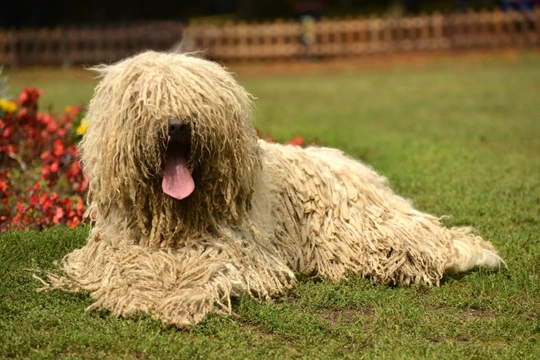
Telling the difference between the Komondor and the Hungarian puli dog breeds
The Komondor and the Hungarian puli are two separate pedigree dog breeds that have one very unusual trait in common – their adult coats grow into long cords or dreadlocks, which gives both breeds a distinctive appearance and makes them very memorable.
Because it is uncommon to see dogs with a coat like the puli and the Komondor, many people get the two breeds confused – or even think that they are one and the same. As well as the dreadlocked coat, there are a number of other notable similarities between the two breeds too – but look below the surface of those long, corded coats, and they are two very different dogs.
In this article we will explain the differences (and similarities) between the Komondor and the Hungarian puli, to make it easy for you to tell the difference. Read on to learn more.
The puli and Komondor origins
Both the Komondor and the Hungarian puli share similar early origins, and both breeds began in Hungary, where they were used as working herding dogs. Pulis and Komondors often worked side by side together with shepherds to guard and herd sheep and other livestock.
Traditionally, Komondors and pulis worked in separate shifts – with the puli functioning as more of a herding dog during the daytime and the Komondor taking the night watchman role. The Komondor would guard against and see off potentially large predators like wolves – and if needed, would alert the shepherd and puli contingent too to get a little extra support if required.
The coat traits of the puli and Komondor
Both breeds have an adult coat that forms into cords or dreadlocks, and which served a number of purposes in their working history. This type of coat is very hardy and weather resistant, and helps to protect dogs in undergrowth and thorns. It also offers an additional layer of protection when defending against predators, because when they attack they are likely to get a mouthful of hair and not skin!
Contrary to what many people expect, neither the Komondor or puli coat is low-maintenance – to keep a dreadlocked coat clean and in good condition actually involves a lot of work, and committed, specialist grooming to part the cords and avoid the coat matting up.
In terms of the coat colours of the two respective breeds, Komondors are only found in white – but the Hungarian puli coat can be either white, grey or black. This means if you see a dreadlocked dog in a shade other than white, it is a fairly safe bet that you’re looking at a puli – but if the coat is white, it could be either breed and so you will need to do some more detective work!
Other physical traits
The Hungarian puli and the Komondor differ significantly in size, with the Komondor being by far the larger of the two dogs. Komondors stand between 60-80cm tall at the withers, and can weigh between 36-61kg. Pulis, on the other hand, stand between 37-44cm tall, and weigh between 10-15kg.
This big difference in size is one of the most helpful criteria to use to tell the two breeds apart – so if you’re looking at a large white dreadlocked dog it is likely to be a Komondor, while a smaller one is almost certain to be a puli.
This does mean that grooming and caring for the puli coat is rather less time consuming and challenging than for the Komondor, although both breeds are fairly high maintenance in that department!
Temperament comparisons
The Komondor makes for a better guard dog than a puli, as is reflected in their historical working guarding role. The two breeds do have a lot of temperament traits in common, however, including a generally protective and loyal nature, and a strong devotion to their families and owners.
They are loving and affectionate, forming strong bonds with their owners, and both breeds also have soulful, gentle natures. They can be sensitive to change and upheaval, and like all dogs, thrive when they have security and a set routine.
Both breeds are also outgoing and love to spend time outside, being quite active breeds that have a high level of tenacity and dedication within working roles. They can be rather obsessive when something catches their attention, but they tend to be amenable to training, responsive to commands, and reliable in terms of their responses.
They are also both hardy and robust breeds that aren’t afraid to get mucky or go dashing through puddles and brambles – which of course, makes caring for and maintaining their coats more challenging!
The Komondor tends to be slightly lazier and more sedentary than the puli, as their original working role was as more of a guard dog and watchdog than a working herding dog, which means that the puli is the more energetic of the two breeds. The Komondor can also be more territorial and prone to guarding, often being very protective of their owners.
Hungarian pulis are more inquisitive and playful, having higher energy levels but generally, a rather more laid-back approach to life.
Whilst the two breeds have a lot in common, they also have rather different core personality traits and of course, are very different in size, which means that knowing the difference between the two rather than viewing both breeds as being very similar is important.



